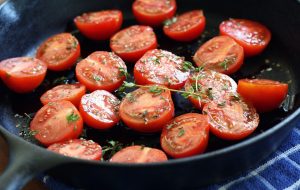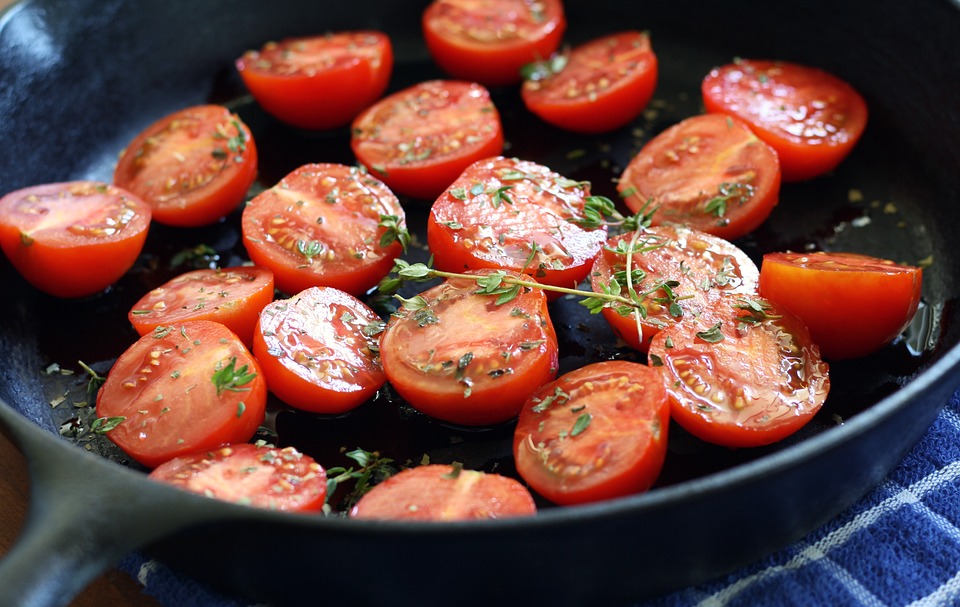
Years ago, I made an investment into cast iron skillets to use in an off-grid environment. We frequently went camping and I needed to find cookware that could be used indoors, as well as outdoors. Additionally, I had just started reading about all of the health risks related to non-stick cookware and the perfluorocarbons (PFCs), a chemical linked to liver damage, cancer, developmental problems. PFCs are released from nonstick pans in the form of fumes when pans are heated on high heat. They can be inhaled and even ingested when the surface of the pan gets scratched. After reading about this, I made the decision not to gamble with my family’s health. I was introduced to the Lodge brand cast iron ware and have never looked back.
At first, I started out with the very basic 3-quart combo cooker. It comes with a Dutch oven with a handle and a skillet that can be used as a lid. I have made everything from my famous (well, my family thinks it is) cornbread, to braising tough pieces of meat, to baking cakes – it really is that versatile. As my fellow cast iron cookers will probably understand, I fell in love with this type of cookware and quickly added onto to my meager collection and purchased a 5-piece set.
There are two types of cast iron cookware sets – the enamel coated and the traditional cast iron cookware. This article is based on cooking with the traditional set. There is nothing wrong with the enamel coated sets, but I have only used the traditional.
So, Why Are Cast Iron Pots So Great?
Cast iron pots are built to last! They are made from pouring molten iron into molds.
“The molten cast iron is poured down between two sand molds to create each piece of cast iron, then the formed cookware is shaken and tumbled to remove molding sand. The cookware is shot blasted with a fine steel shot to remove any residual molding sand, then it’s ground, polished, rinsed, and hung to dry with a steam dryer.” Source
Once the pots are formed, the iron pot will have tiny pores that absorb flavors and grease, which, over time create that natural, non-stick “seasoned” surface we all love.
A quick note about Dutch ovens
Did you know that a Dutch oven was among the gear Lewis and Clark carried when they explored the great American Northwest in 1804–1806? Perhaps they brought it because you can cook or bake virtually anything in them. As well, Dutch ovens are called ovens because they utilize convection heat transfer like an actual oven does. Dutch ovens are built with heavy walls and lids so the heat is trapped inside creating a circulating convection wave that evenly cooks the food.
Many suggest not to fill your Dutch oven over two-thirds full in order to create proper convection throughout the food. Over the years we’ve modified old family favorites for use in a Dutch oven as well as finding new ones. Here are a few recipes that we have come to love, especially when cooked in our Dutch oven.
Cast Iron Cookware is Highly Recommended in the Prepper/Survival Community
Those preparing for long-term emergencies where power could be disrupted for days, weeks or longer should consider investing in cast iron pots. The reason being is this type of cookware was made to last! As well, they are a suitable alternative cooking source to use in preparing food in an off-grid environment. Because they can take a beating and be used with large amounts of heat, they can be used over hot coals, on a grill or oven an open flame. As well, they are easy to prepare food in. Many underestimate how stressful an off-grid emergency is and you will want convenient cooking methods at your disposal.
Read about the 10 Rules For Your Emergency Food Pantry
You will literally want a way that you can quickly add foods and not worry about them burning. The main drawback to cast iron is the sheer weight of this type of cookware. Therefore, I suggest you have them already at your bug out location or, if you decide to bug in, have them on hand.
Here are some other great reasons why cast iron would be a great investment for preppers.
10 Reasons Why Cast Iron Cookware Is So Awesome!
- Can last a lifetime. The folks over at Lodge Cast Iron Manufacturing boast that “Because you create, maintain, and even repair the “seasoning”, your cookware can last 100 years or more. Chemical non-stick coating cannot be repaired, limiting lifespan.”
- Off Grid capable
- Retains heat and evenly distributes it more efficiently
- Perfect texture in foods. crispy/moist
- Best bang for your buck! While nonstick skillets have to be replaced over time, cast iron products gets better over time.
- If seasoned properly, cast iron has a natural nonstick coating and will not need as much oil as other pots would need to cook food on.
- Efficient for all types of cooking. One aspect that I love about cast iron is I can start a meal on the stove and finish it in the oven. That means less dishes to clean.
- It’s chemical-free! So you do not have to worry about chemicals leaching into your food.
- Easy to clean
- It can double as a deadly weapon. Have you ever known anyone to get up after being hit with a cast iron skillet? I didn’t think so.
As well, there are health benefits attributed to using cast iron cooking sets. While cast iron do not leach chemicals, it can transfer some iron into your food. Since iron deficiency is fairly common worldwide, (especially among women), this is not a bad thing. In fact, 10% of American women are iron-deficient. Cooking food, especially something acidic like tomato sauce in a cast-iron skillet can increase iron content, by as much as 20 times. If you suffer from too much iron in your body system, consult a physician about whether or not to use cast iron cookware.
Caring for Cast Iron
To soap, or not to soap. There is some controversy in applying water and soap to cast iron. Some feel that soap will break up the tiny oil molecules that are embedded on the pan and make it not-so-nonstick and ruin all of your seasoning efforts. It’s also possible that the next thing you cook it will have a slightly soapy taste to it! According to Lodge Cast Iron Manufacturing, these are the proper steps to take when cleaning and seasoning your cast iron cookware:
For Minimal Cleaning:
- Hand wash. Dry immediately—even before first use.
- Rub with a light coat of vegetable oil after every wash.
- How much oil? Enough to restore the sheen, without being “sticky”.
- Why? To keep the iron “seasoned” and protected from moisture.
Tips of Cleaning:
As well, avoid using abrasive cleaners, steel wool and putting your cast iron cookware in the dishwasher as this can strip the sacred seasoning off. These are cast iron cooking no-no’s. If there is bits of food stuck to the pan, use coarse salt and gently scrub until the food comes off. As well, many recommend that you clean the skillet immediately after use, while it is still hot or warm. This isn’t the type of cookware that you can fill with soapy water and set it on the counter overnight. Doing so could cause the cast iron to rust.
Tips For Seasoning:
That lovely sheen on cast-iron cookware is the sign of a well-seasoned pan, which renders it virtually nonstick.
To season your cast-iron skillet:
- Rub it with a relatively thin coat of neutral cooking oil, such as vegetable oil or even leftover bacon grease.
- Place the lightly-oiled cast iron pan, upside down, in the oven, with a sheet of aluminum foil on the bottom to catch any drips. Heat the pan for 30 minutes in a 450 to 500 degree F. oven. Once done, turn off the oven, and let the pan cool to room temperature in the oven. Repeating this process several times is recommended as it will help create a stronger “seasoning” bond. I usually do this process 3 to 4 times. NOTE: Seasoning cast iron pans does generate smoke similar to cooking in a dirty oven.
Note: The oil fills the cavities and becomes entrenched in them, as well as rounding off the peaks. By seasoning a new pan, the cooking surface develops a nonstick quality because the formerly jagged and pitted surface becomes smooth. Also, because the pores are permeated with oil, water cannot seep in and create rust that would give food an off-flavor. Your ironware will be slightly discolored at this stage, but a couple of frying jobs will help complete the cure, and turn the iron into the rich, black color that is the sign of a well-seasoned, well-used skillet or pot. - Never put cold liquids into a very hot cast iron pan or oven. They will crack on the spot!
- Be careful when cooking with your cast iron pans on an electric range, because the burners create hot spots that can warp cast iron or even cause it to crack. Be sure to preheat the iron very slowly when using an electric range and keep the settings to medium or even medium-low.
Also, if the pan does get rusty or lose its seasoning at any point, you can always re-season it and get a fresh start. Learn how to refurbish and re-season rusty cast iron.
To conclude, cast iron pots and Dutch ovens may seem old-fashioned to some, but for those who are looking at making long-term living investments for sustainable living, this is the cookware of your dreams. They are dependable and are cooking work horses suitable for indoor cooking or in off-grid environments and are easy to care for.
Tess Pennington is the author of The Prepper’s Blueprint, a comprehensive guide that uses real-life scenarios to help you prepare for any disaster. Because a crisis rarely stops with a triggering event the aftermath can spiral, having the capacity to cripple our normal ways of life. The well-rounded, multi-layered approach outlined in the Blueprint helps you make sense of a wide array of preparedness concepts through easily digestible action items and supply lists.
Tess is also the author of the highly rated Prepper’s Cookbook, which helps you to create a plan for stocking, organizing and maintaining a proper emergency food supply and includes over 300 recipes for nutritious, delicious, life-saving meals.
Visit her web site at ReadyNutrition.com for an extensive compilation of free information on preparedness, homesteading, and healthy living.
This information has been made available by Ready Nutrition
